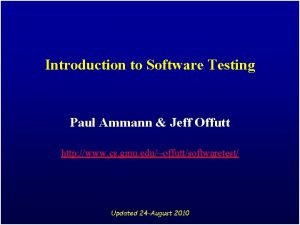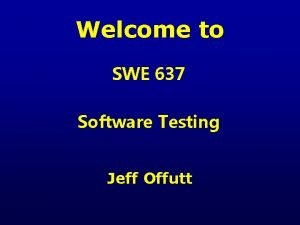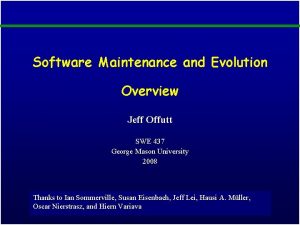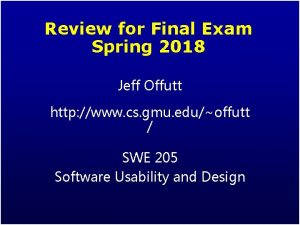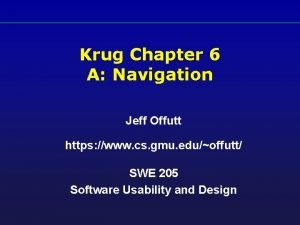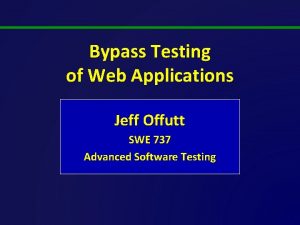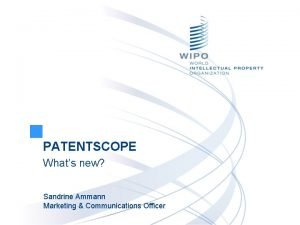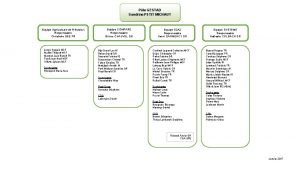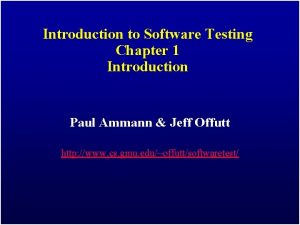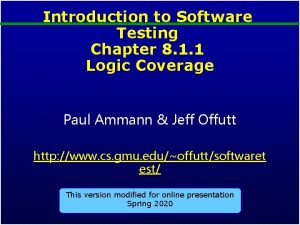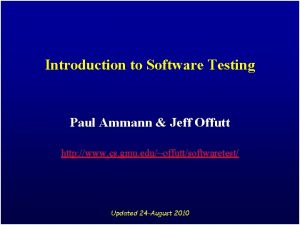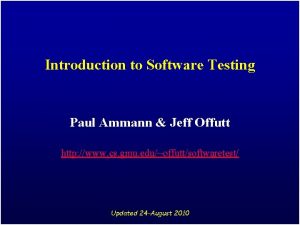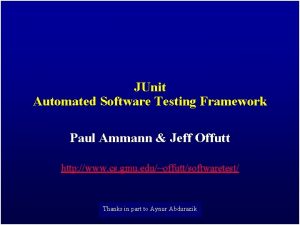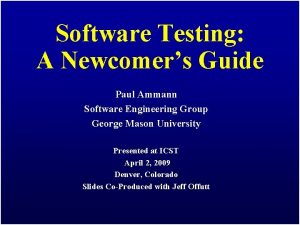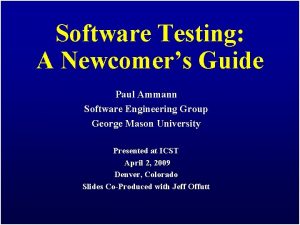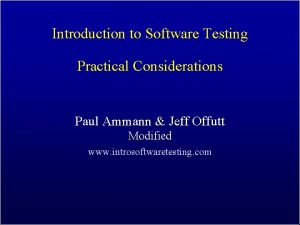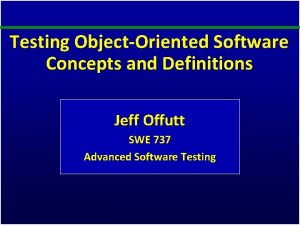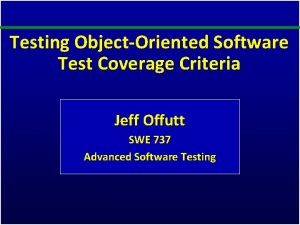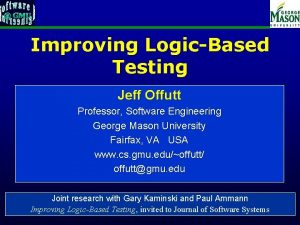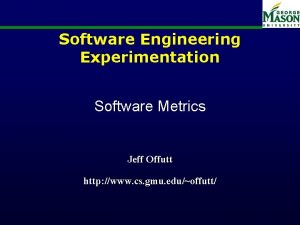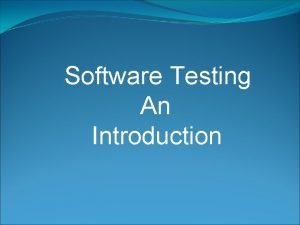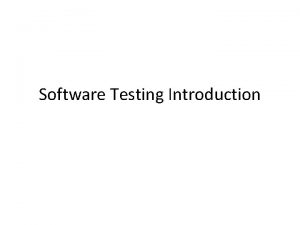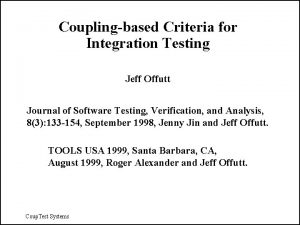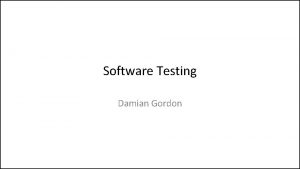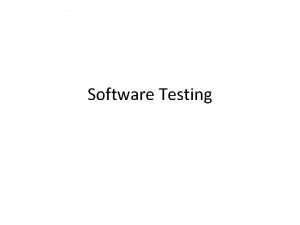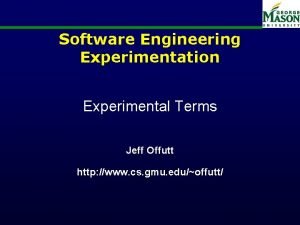Introduction to Software Testing Paul Ammann Jeff Offutt



































- Slides: 35

Introduction to Software Testing Paul Ammann & Jeff Offutt http: //www. cs. gmu. edu/~offutt/softwaretest/ Updated 24 -August 2010

OUTLINE 1. Spectacular Software Failures 2. Why Test? 3. What Do We Do When We Test ? • Test Activities and Model-Driven Testing 4. Software Testing Terminology 5. Changing Notions of Testing 6. Test Maturity Levels 7. Summary Introduction to Software Testing (Ch 1) © Ammann & Offutt 2

Software Testing Terms n Like any field, software testing comes with a large number of specialized terms that have particular meanings in this context n Some of the following terms are standardized, some are used consistently throughout the literature and the industry, but some vary by author, topic, or test organization n The definitions here are intended to be the most commonly used Introduction to Software Testing (Ch 1) © Ammann & Offutt 3

Important Terms Validation & Verification (IEEE) n Validation : The process of evaluating software at the end of software development to ensure compliance with intended usage n Verification : The process of determining whether the products of a given phase of the software development process fulfill the requirements established during the previous phase IV&V stands for “independent verification and validation” Introduction to Software Testing (Ch 1) © Ammann & Offutt 4

Test Engineer & Test Managers n Test Engineer : An IT professional who is in charge of one or more technical test activities – – – n designing test inputs producing test values running test scripts analyzing results reporting results to developers and managers Test Manager : In charge of one or more test engineers – sets test policies and processes – interacts with other managers on the project – otherwise helps the engineers do their work Introduction to Software Testing (Ch 1) © Ammann & Offutt 5

Static and Dynamic Testing n Static Testing : Testing without executing the program – This include software inspections and some forms of analyses – Very effective at finding certain kinds of problems – especially “potential” faults, that is, problems that could lead to faults when the program is modified n Dynamic Testing : Testing by executing the program with real inputs Introduction to Software Testing (Ch 1) © Ammann & Offutt 6

Software Faults, Errors & Failures n Software Fault : A static defect in the software n Software Failure : External, incorrect behavior with respect to the requirements or other description of the expected behavior n Software Error : An incorrect internal state that is the manifestation of some fault Faults in software equivalent to design mistakes in hardware. They were there at the beginning and do not “appear” when a part wears out. Introduction to Software Testing (Ch 1) © Ammann & Offutt 7

Testing & Debugging n Testing : Finding inputs that cause the software to fail n Debugging : The process of finding a fault given a failure Introduction to Software Testing (Ch 1) © Ammann & Offutt 8

Fault & Failure Model Three conditions necessary for a failure to be observed 1. Reachability : The location or locations in the program that contain the fault must be reached 2. Infection : The state of the program must be incorrect 3. Propagation : The infected state must propagate to cause some output of the program to be incorrect Introduction to Software Testing (Ch 1) © Ammann & Offutt 9

Test Case n Test Case Values : The values that directly satisfy one test requirement n Expected Results : The result that will be produced when executing the test if the program satisfies it intended behavior Introduction to Software Testing (Ch 1) © Ammann & Offutt 10

Observability and Controllability n Software Observability : How easy it is to observe the behavior of a program in terms of its outputs, effects on the environment and other hardware and software components – Software that affects hardware devices, databases, or remote files have low observability n Software Controllability : How easy it is to provide a program with the needed inputs, in terms of values, operations, and behaviors – Easy to control software with inputs from keyboards – Inputs from hardware sensors or distributed software is harder – Data abstraction reduces controllability and observability Introduction to Software Testing (Ch 1) © Ammann & Offutt 11

Inputs to Affect Controllability and Observability n Prefix Values : Any inputs necessary to put the software into the appropriate state to receive the test case values n Postfix Values : Any inputs that need to be sent to the software after the test case values n Two types of postfix values 1. Verification Values : Values necessary to see the results of the test case values 2. Exit Commands : Values needed to terminate the program or otherwise return it to a stable state n Executable Test Script : A test case that is prepared in a form to be executed automatically on the test software and produce a report Introduction to Software Testing (Ch 1) © Ammann & Offutt 12

Stress Testing Tests that are at the limit of the software’s expected input domain Very large numeric values (or very small) n Very long strings, empty strings n Null references n Very large files n Many users making requests at the same time n Invalid values n Introduction to Software Testing (Ch 1) © Ammann & Offutt 13

Top-Down and Bottom-Up Testing n Top-Down Testing : Test the main procedure, then go down through procedures it calls, and so on n Bottom-Up Testing : Test the leaves in the tree (procedures that make no calls), and move up to the root. – Each procedure is not tested until all of its children have been tested Introduction to Software Testing (Ch 1) © Ammann & Offutt 14

White-box and Black-box Testing n n n Black-box testing : Deriving tests from external descriptions of the software, including specifications, requirements, and design White-box testing : Deriving tests from the source code internals of the software, specifically including branches, individual conditions, and statements Model-based testing : Deriving tests from a model of the software (such as a UML diagram MDTD makes these distinctions less important. The more general question is: from what level of abstraction to we derive tests? Introduction to Software Testing (Ch 1) © Ammann & Offutt 15

Old : Testing at Different Levels main Class P Class A Acceptance testing: Is the software acceptable to the user? n System testing: Test the overall functionality of the system n Integration testing: Test how modules interact with each other n Module testing: Test each class, file, module or component n Unit testing: Test each unit (method) individually Class B method m. A 1() method m. B 1() method m. A 2() method m. B 2() This view obscures underlying similarities Introduction to Software Testing (Ch 1) n © Ammann & Offutt 16

OUTLINE 1. Spectacular Software Failures 2. Why Test? 3. What Do We Do When We Test ? • Test Activities and Model-Driven Testing 4. Software Testing Terminology 5. Changing Notions of Testing 6. Test Maturity Levels 7. Summary Introduction to Software Testing (Ch 1) © Ammann & Offutt 17

Changing Notions of Testing n Old view considered testing at each software development phase to be very different form other phases – Unit, module, integration, system … n New view is in terms of structures and criteria – Graphs, logical expressions, syntax, input space n Test design is largely the same at each phase – Creating the model is different – Choosing values and automating the tests is different Introduction to Software Testing (Ch 1) © Ammann & Offutt 18

New : Test Coverage Criteria A tester’s job is simple : Define a model of the software, then find ways to cover it g Test Requirements : Specific things that must be satisfied or covered during testing g Test Criterion : A collection of rules and a process that define test requirements Testing researchers have defined dozens of criteria, but they are all really just a few criteria on four types of structures … Introduction to Software Testing (Ch 1) © Ammann & Offutt 19

Criteria Based on Structures : Four ways to model software 1. Graphs 2. Logical Expressions 3. Input Domain Characterization 4. Syntactic Structures Introduction to Software Testing (Ch 1) (not X or not Y) and A and B A: {0, 1, >1} B: {600, 700, 800} C: {swe, cs, isa, infs} if (x > y) z = x - y; else z = 2 * x; © Ammann & Offutt 20

Source of Structures n These structures can be extracted from lots of software artifacts – Graphs can be extracted from UML use cases, finite state machines, source code, … – Logical expressions can be extracted from decisions in program source, guards on transitions, conditionals in use cases, … n This is not the same as “model-based testing, ” which derives tests from a model that describes some aspects of the system under test – The model usually describes part of the behavior – The source is usually not considered a model Introduction to Software Testing (Ch 1) © Ammann & Offutt 21

1. Graph Coverage – Structural 2 1 6 5 Node Edge (Branch) Path (Statement) Cover every edge Covereverynode path 3 This graph may represent • statements & branches • methods & calls 7 4 • • • 12567 • • • 1343567 1257 • • 1357 13567 • components & signals • 1357 • states and transitions • 1343567 Introduction to Software Testing (Ch 1) © Ammann & Offutt • 134357 … 22

1. Graph Coverage – Data Flow def = {m} def = {a , m} use = {y} 2 def = {x, y} use = {x} 6 use = {a} 1 5 use = {x} def = {a} use = {m} 7 Defs & Uses Pairs All. Defs Uses • Every (x, 1, (1, 2)), (x, 1, once (1, 3)) def used Every def “reaches” every 3 • (y, use 1, 4), (y, 1, 6) This graph contains: • defs: nodes & edges where variables get values • uses: nodes & edges where values are accessed 4 def = {m} use = {y} • 1, 2, 5, 6, 7 • (a, 2, (5, 6)), (a, 2, (5, 7)), (a, • • 1, 1, 2, 2, 5, 5, 76, 7 3, (5, 6)), (a, 3, (5, 7)), • 1, 1, 3, 2, 4, 5, 3, (m, 7 5, 4, 7 7), (m, 6, 7) • • (m, 2, 7), • 1, 3, 5, 6, 7 • 1, 3, 5, 7 • 1, 3, 4, 3, 5, 7 Introduction to Software Testing (Ch 1) © Ammann & Offutt 23

1. Graph - FSM Example Memory Seats in a Lexus ES 300 Guard (safety constraint) Trigger (input) [Ignition = off] | Button 2 Driver 2 Configuration Driver 1 Configuration [Ignition = off] | Button 1 [Ignition = on] | seat. Back () (to Modified) Ignition = off New Configuration Driver 2 Ignition = off [Ignition = on] | seat. Bottom () [Ignition = on] | lumbar () [Ignition = on] | side. Mirrors () [Ignition = on] | Reset AND Button 2 New Configuration Driver 1 Modified Configuration [Ignition = on] | Reset AND Button 1 Introduction to Software Testing (Ch 1) © Ammann & Offutt 24

2. Logical Expressions ( (a > b) or G ) and (x < y) Transitions Logical Program Decision Statements Expressions Software Specifications Introduction to Software Testing (Ch 1) © Ammann & Offutt 25

2. Logical Expressions ( (a > b) or G ) and (x < y) n Predicate Coverage : Each predicate must be true and false – ( (a>b) or G ) and (x < y) = True, False n Clause Coverage : Each clause must be true and false – (a > b) = True, False – G = True, False – (x < y) = True, False n Combinatorial Coverage : Various combinations of clauses – Active Clause Coverage: Each clause must determine the predicate’s result Introduction to Software Testing (Ch 1) © Ammann & Offutt 26

2. Logic – Active Clause Coverage ( (a > b) or G ) and (x < y) With these values for G and (x<y), (a>b) determines the value of the predicate Introduction to Software Testing (Ch 1) 1 T F T 2 F F T 3 F T T 4 F F T 5 T T T 6 T T F © Ammann & Offutt duplicate 27

3. Input Domain Characterization n Describe the input domain of the software – Identify inputs, parameters, or other categorization – Partition each input into finite sets of representative values – Choose combinations of values n System level – Number of students – Level of course – Major n { 0, 1, >1 } { 600, 700, 800 } { swe, cs, isa, infs } Unit level – Parameters F (int X, int Y) – Possible values X: { <0, 0, 1, 2, >2 }, Y : { 10, 20, 30 } – Tests • F (-5, 10), F (0, 20), F (1, 30), F (2, 10), F (5, 20) Introduction to Software Testing (Ch 1) © Ammann & Offutt 28

4. Syntactic Structures n n Based on a grammar, or other syntactic definition Primary example is mutation testing 1. 2. 3. 4. n Induce small changes to the program: mutants Find tests that cause the mutant programs to fail: killing mutants Failure is defined as different output from the original program Check the output of useful tests on the original program Example program and mutants if (x > y) z = x - y; else z = 2 * x; Introduction to Software Testing (Ch 1) if (x > y) if (x >= y) z = x - y; z = x + y; z = x – m; else z = 2 * x; © Ammann & Offutt 29

Coverage Overview Four Structures for Modeling Software Graphs Logic Input Space Syntax Applied to Source FSMs Specs Source Specs Design Introduction to Software Testing (Ch 1) Applied to DNF Source Models Integ Use cases © Ammann & Offutt Input 30

Coverage Given a set of test requirements TR for coverage criterion C, a test set T satisfies C coverage if and only if for every test requirement tr in TR, there is at least one test t in T such that t satisfies tr n Infeasible test requirements : test requirements that cannot be satisfied – No test case values exist that meet the test requirements – Dead code – Detection of infeasible test requirements is formally undecidable for most test criteria n Thus, 100% coverage is impossible in practice Introduction to Software Testing (Ch 1) © Ammann & Offutt 31

Two Ways to Use Test Criteria 1. Directly generate test values to satisfy the criterion often assumed by the research community most obvious way to use criteria very hard without automated tools 2. Generate test values externally and measure against the criterion usually favored by industry – sometimes misleading – if tests do not reach 100% coverage, what does that mean? Test criteria are sometimes called metrics Introduction to Software Testing (Ch 1) © Ammann & Offutt 32

Generators and Recognizers Generator : A procedure that automatically generates values to satisfy a criterion n Recognizer : A procedure that decides whether a given set of test values satisfies a criterion n Both problems are provably undecidable for most criteria n It is possible to recognize whether test cases satisfy a criterion far more often than it is possible to generate tests that satisfy the criterion n Coverage analysis tools are quite plentiful n Introduction to Software Testing (Ch 1) © Ammann & Offutt 33

Comparing Criteria with Subsumption n Criteria Subsumption : A test criterion C 1 subsumes C 2 if and only if every set of test cases that satisfies criterion C 1 also satisfies C 2 n Must be true for every set of test cases Example : If a test set has covered every branch in a program (satisfied the branch criterion), then the test set is guaranteed to also have covered every statement n Introduction to Software Testing (Ch 1) © Ammann & Offutt 34

Test Coverage Criteria Traditional software testing is expensive and laborintensive n Formal coverage criteria are used to decide which test inputs to use n More likely that the tester will find problems n Greater assurance that the software is of high quality and reliability n A goal or stopping rule for testing n Criteria makes testing more efficient and effective n But how do we start to apply these ideas in practice? Introduction to Software Testing (Ch 1) © Ammann & Offutt 35
 Jeff offutt
Jeff offutt Jeff offutt
Jeff offutt Swe 619 gmu
Swe 619 gmu Jeff offutt
Jeff offutt Jeff offutt
Jeff offutt Jeff offutt
Jeff offutt Swe 432 gmu
Swe 432 gmu Gmu final exam locator
Gmu final exam locator Domain testing in software testing
Domain testing in software testing Motivational overview in software testing
Motivational overview in software testing Data flow testing strategies in software testing
Data flow testing strategies in software testing Globalization testing example
Globalization testing example Language testing
Language testing Control structure testing in software engineering
Control structure testing in software engineering Decision table testing in software testing
Decision table testing in software testing Decision table for triangle problem
Decision table for triangle problem Decision table based testing
Decision table based testing Rigorous testing in software testing
Rigorous testing in software testing Testing blindness in software testing
Testing blindness in software testing Domain testing in software testing
Domain testing in software testing Ron offutt house
Ron offutt house Sandrine ammann
Sandrine ammann Ammann online marketing
Ammann online marketing Ammann online marketing
Ammann online marketing Patentscop
Patentscop Pierre ammann
Pierre ammann Sandrine ammann
Sandrine ammann Slidetodoc
Slidetodoc Hrvatsko asfaltersko društvo
Hrvatsko asfaltersko društvo Introduction software testing
Introduction software testing Introduction to software testing exercises solutions
Introduction to software testing exercises solutions Positive negative testing
Positive negative testing Static testing and dynamic testing
Static testing and dynamic testing Neighborhood integration testing
Neighborhood integration testing Contoh pengujian equivalence partitioning
Contoh pengujian equivalence partitioning Behavioral testing adalah
Behavioral testing adalah
